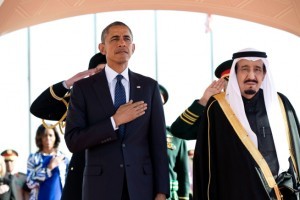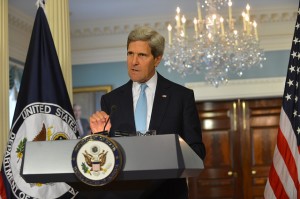
Sunday, 15 January 2017
How Obama Spread the Mideast Fires

Daniel Lazare is the author of several books including The Frozen Republic: How the Constitution Is Paralyzing Democracy (Harcourt Brace)With President Obama down to less than two weeks in office, everyone is busy assessing his legacy. So let’s begin with the Arab world. Not since the Vietnam War, we can safely say, has an administration left a region in ruins the way Obama has left the Middle East (although it’s true that George W. Bush contributed mightily to the mess).
President Obama and King Salman Arabia stand at attention during the U.S. national anthem as the First Lady stands in the background with other officials on Jan. 27, 2015, at the start of Obama’s State Visit to Saudi Arabia. (Official White House Photo by Pete Souza)
But Obama has expanded the chaos outward from Bush’s legacy wars in Iraq and Afghanistan, now including Libya, Syria and Yemen with ripple effects from the refugee flows extending into Turkey and even into Europe. Terrorism is exploding, entire nations have been reduced to war zones, while religious sectarianism is raging out of control.
Of course, not all of it is Obama’s fault. After all, he didn’t start the Sunni-Shia conflict, which dates back to the mid-Seventh Century, nor is he responsible for Arab-Persian ethnic tensions in general, which go back even farther. But he breathed new life into such forces and enabled them to achieve a new kind of prominence, with consequences that are little short of breathtaking.
How did someone so charming and seemingly so progressive wreak such havoc? The answer is through a combination of weakness, complacency, and taking the easy way out. Obama is the sort of cool and laid-back individual who adapts effortlessly to whatever institution he finds himself in, whether it’s the Harvard Law Review, the Illinois state legislature, the U.S. Senate or the White House.
The writer Edward L. Fox argues that, during his childhood in Indonesia, he soaked up the Javanese doctrine of halus in which a king “does not conquer opposing political forces, but absorbs them all under himself.” Instead of meeting conflict head on, the king floats serenely above it. The idea is to “let your opponent yell and scream, listen politely, and then, when your adversary has exhausted himself, somehow end up winning.”
Whereas someone a little less afraid of getting his hair mussed might have confronted “the Blob,” as Washington’s pro-war foreign-policy establishment is known, Obama decided to name Hillary Clinton, one of its chief standard-bearers, as Secretary of State, and keep Robert Gates, another pillar of the national security establishment, as Secretary of Defense.
Rather than fighting what President Dwight Eisenhower dubbed the “military-industrial complex,” Obama’s idea was to disarm it by bringing some of its chief advocates into his inner circle and perhaps give his own standing a boost as well. But what it chiefly did was to provide the War Party with a new lease on life.
More Conflict, Not Less
The upshot was more conflict rather than less. John Kerry, Clinton’s no-less-bellicose successor, made this clear in his much-ballyhooed Dec. 28 speech about the breakdown in Israeli-Palestinian negotiations.
U.S. Secretary of State John Kerry delivers remarks on Syria at the Department of State in Washington, D.C., on Aug. 30, 2013. [State Department photo]
Although the address has been hailed in certain quarters as an attempt to put peace back on track, a careful reading reveals something very different: the epic two-state talks between Israel and Palestine were not about peace, but about tamping down conflict in one corner of the Middle East so that the U.S. could pursue various imperial misadventures in others. Kerry revealed as much by declaring that all of America’s allies have “common interests in countering Iran’s destabilizing activities.”
The 2002 Saudi Initiative, which served as the basis for the latest failed Israeli-Palestinian peace talks, not only called for an Israeli-Palestinian accord, but for a regional defense agreement aimed at keeping the Persians out.
The framework, Kerry went on, “envisages Israel being a partner in those efforts when peace [with the Palestinians] is made. This is the area where Israel and the Arab world are looking at perhaps the greatest moment of potential transformation in the Middle East since Israel’s creation in 1948. The Arab world faces its own set of security challenges. With Israeli-Palestinian peace, Israel, the United States, Jordan, Egypt – together with the GCC [Gulf Cooperation Council] countries – would be ready and willing to define a new security partnership for the region that would be absolutely groundbreaking.”
This was the old goal of a “GCC + 2” security umbrella in which Israel and the Palestinians would forget their differences and join with Egypt, Jordan, and the six members of the GCC – Saudi Arabia, Qatar, Kuwait, Bahrain, the United Arab Emirates, and Oman – to form a united front against a non-Arab intruder, Iran.
The alliance thus had an ethnic dimension right from the start. But it also had a religious dimension since all eight Arab nations are Sunni or Sunni-controlled with the minor exception of Oman. So, GCC + 2 would only pave the way for a growing sectarian conflict between Wahhabism, the stringent form of Sunni orthodoxy that is the official state ideology in Saudi Arabia, the dominant member of the GCC, and Iranian Shi‘ism.
But since Shi‘ism is not confined to a single nation but is actually the majority religion throughout the Persian Gulf area, it was a formula for something even worse, an all-out regional struggle between the Sunni states led by Riyadh on one hand and, on the other, an Iranian-dominated “Shi‘ite crescent” stretching from Lebanon and Syria to Bahrain, Yemen, and the Saudis’ own Eastern Province, the center of both its oil industry and its 15 percent Shi‘ite minority.
The Worst Passions
It was a strategy guaranteed to excite the worst passions on both sides of the divide. It was a recipe not only for war but for religious war, which is the worst kind. Not surprisingly, violence exploded, and more than a million refugees were sent fleeing toward Europe, a human inundation that is now roiling the political waters from Paris to Warsaw.
U.S. Secretary of State Hillary Clinton meets with Saudi King Abdullah in Riyadh on March 30, 2012. [State Department photo]
Yet, Obama – with his Javanese penchant for reconciling opposites – has shown a strange combination of vision and blindness throughout the debacle. He spoke up in favor of human rights. But at his first meeting with Saudi King Abdullah, he bowed deeply and apparently kissed his hand, a curious gesture for a young progressive encountering one of the world’s greatest despots but it was a sign of hypocrisies to come. Obama protested loudly when Bashar al-Assad’s cracked down on Sunni-led Arab Spring protests in Syria, but Obama remained silent when Saudi Arabia dispatched troops to crack down on Shi‘ite-led Arab Spring protests in neighboring Bahrain.
Welcoming Abdullah’s equally tyrannical neighbor, Qatar’s Hamad bin Khalifa al-Thani, in April 2011, Obama uttered the usual diplomatic boilerplate, expressing appreciation for “the leadership that the emir has shown when it comes to democracy in the Middle East.” But he was franker in private.
Not realizing that he was speaking into an open mike, he told donors at a Democratic fundraiser in Chicago later that evening that Al-Thani was a “pretty influential guy. He is a big booster, big promoter of democracy all throughout the Middle East. Reform, reform, reform – you’re seeing it on Al Jazeera. Now, he himself is not reforming significantly. There’s no big move towards democracy in Qatar. But you know part of the reason is that the per capita income of Qatar is $145,000 a year. That will dampen a lot of conflict.”
In fact, Al-Thani is a lawless autocrat who, according to Obama’s own State Department, prohibits organized political parties, restricts civil liberties “including freedoms of speech, press, and assembly and access to a fair trial,” and countenances human trafficking “primarily in the domestic worker and labor sectors.” But since he has oodles of oil and natural gas and is friendly to the U.S. besides, he gets a free pass.
Double your standards, double your fun. A month later, Obama gave a major address in which he called for “freedom of religion, equality for men and women under the rule of law, and the right to choose your own leaders – whether you live in Baghdad or Damascus, Sanaa, or Tehran.” But he remained studiously silent about Saudi Arabia, America’s chief ally in the region, where the rule of law is nonexistent and the status of women is probably the worst in the world.
While urging freedom for Egypt’s Christian minority, he said nothing about how the Saudis routinely arrest Christians for the “crime” of attending underground services, close down Shia mosques, or tolerate dangerous sectarian rhetoric in which Sunni routinely clerics accuse “evil Shias” of “set[ting] traps for monotheism and for the Sunnis” and seeking to “skin Sunnis and boil them in water.”
Enlisting the Autocracies
But not only did Obama shield the other oil autocracies from criticism, but, on the theory that only Arabs can solve Arab problems, he encouraged them to become more active abroad. The results were uniformly disastrous. Despite Al-Thani’s well-established record as a supporter of the Muslim Brotherhood and similar forces, Hillary Clinton spent much of late March 2011 persuading him to take part in the U.S.-led military effort to overthrow Libyan strongman Muammar Gaddafi, according to an internal State Department memo. When he said yes, the Obama administration was overjoyed.
But Al-Thani took advantage of the deal to distribute some $400 million to Salafist rebels in the form of machine guns, automatic rifles, and ammunition so that they could do to Libya what an earlier generation of U.S.-backed jihadis had done to Afghanistan, i.e. reduce it to chaos.
Saudi Arabia, Qatar and other Sunni-run states responded the same way when the U.S. invited them to fund the uprising against Syria’s leader Bashar al-Assad, an Alawite, a branch of Shi’a Islam. These “friends of Syria” channeled billions of dollars in aid to Salafist rebels determined to impose Saudi-style fundamentalism.
In August 2012, the U.S. Defense Intelligence Agency warned that Salafists, the Muslim Brotherhood, and Al Qaeda were “the major forces driving the insurgency,” that rebels were seeking to establish a “Salafist principality in eastern Syria,” and that “western countries, the gulf states, and Turkey are supporting these efforts” in order to counter the Shi‘ite threat.
In September 2014, Clinton wrote in an email that Saudi Arabia and Qatar were “providing clandestine financial and logistic support to ISIL and other radical Sunni groups” while Vice President Joe Biden admitted the same thing a month later at a talk at Harvard’s Kennedy School:
“Our allies in the region were our largest problem in Syria … the Saudis, the emirates, etc. what were they doing? They were so determined to take down Assad and essentially have a proxy Sunni-Shia war, what did they do? They poured hundreds of millions of dollars and tens of thousands of tons of military weapons into anyone who would fight against Assad except the people who were being supplied were Al Nusra and Al Qaeda and the extremist elements of jihadis coming from other parts of the world.” [Quote starts at 53:25.]
A Spreading Fire
Yet President Obama did nothing to stop this pouring of gasoline on this regional sectarian war. Rather than tamping down the sectarianism, the U.S. facilitated its spread. Chatting with Australian Prime Minister Malcolm Turnbull, Obama remarked how the easy-going Indonesia he remembered as a child was coming under the sway of the harsh and unforgiving Wahhabism taught in Saudi-funded madrassas.
“Aren’t the Saudis your friends?” Turnbull asked. To which Obama could only smile and say: “It’s complicated.” This is Obama-speak for: “I reconcile opposites, but please don’t ask me to explain how.”
Once sectarianism is out of the bag, it’s very hard to put it back in. In Turkey, which President Recep Tayyip Erdogan turned into a transit hub for Syria-bound Salafist fighters at U.S. behest, the country’s 20 percent Alevi minority, which practices a form of Shi‘ism, is hunkering down in anticipation of attacks by Erdogan’s Sunni supporters, ISIS, or both. Since March 2015, Shi‘ite Houthis in Yemen have been fending off an air assault by Saudis convinced that the Houthi fighters are part of some occult Iranian conspiracy aimed at taking over that country as well.
Members of the Saudi ruling elite “see the hand of Iran everywhere and take seriously the declarations in the Iranian press bragging about how Iran now controls four Arab capitals – Baghdad, Sanaa, Beirut, and Damascus,” a Riyadh-based diplomat told the French journalist Alain Gresh. “They are obsessed with Iran,” said another.
The result is a self-fulfilling prophecy in which the Saudis, backed by the U.S., attack Shi‘ite forces before they can attack them, thereby generating yet another round of conflict and recrimination.
Obama adapted to such paranoia all too gracefully and easily. Instead of fighting it, he accepted it as a given and tried to work with it, which only made it worse. The consequence was to tip the entire region into the abyss. Rarely has coolness led to more uncool results.
The views expressed in this article are the sole responsibility of the author and do not necessarily reflect those of the Blog!
Subscribe to:
Post Comments (Atom)


















No comments:
Post a Comment